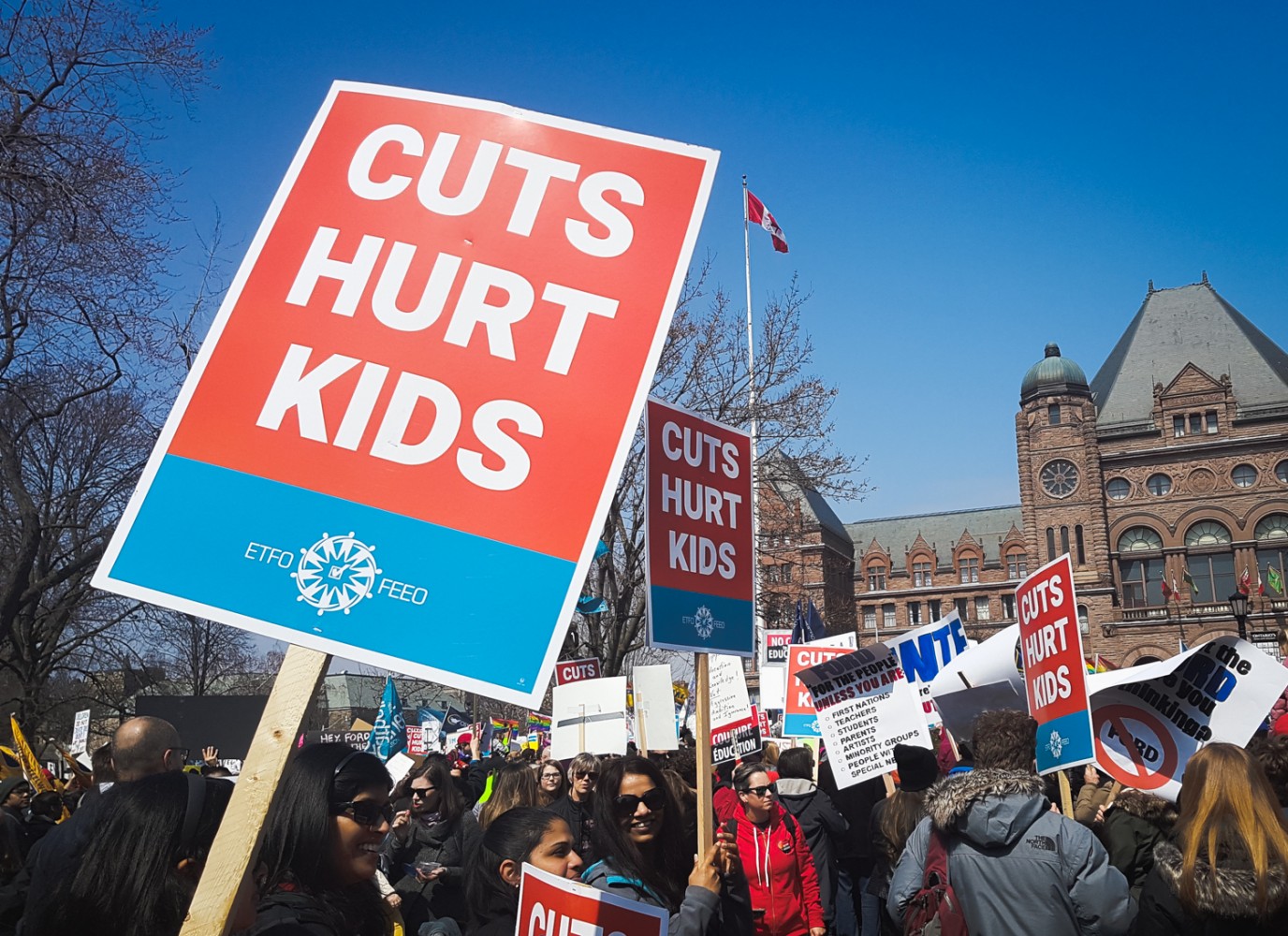
Chronic underfunding in Peel deprives students of critical resources
In the depths of depression, pessimism reigns. Thoughts turn dark, moods plummet and futures look bleak. On those terms, Peel’s education system is most certainly depressed.
Recent projections from the province for education funding show significant reductions across the board in per-student funding, signalling that school boards throughout Ontario will need to learn to do more with less. In Peel Region, schools will be hit even harder as funding projections show Peel boards receiving well below the provincial per-pupil funding average.
Late last week, the Grants for Student Needs (GSN) funding projections for each of the province’s 76 school boards were released. (That followed the announcement that the PCs would invest $1.6 billion into “attrition” funding to ensure no teachers who want to continue working are laid off, even as positions are severely reduced as a result of the government’s decision to bump up the size of secondary school classes.)
The GSN grants are the core source of funding for school boards. The governing PCs are hailing an increase in funding to schools, projecting that spending for 2019-20 will total $24.65 billion, up slightly from the $24.61 billion invested this school year. The additional funds are spread across many key grant areas, providing for classroom needs, school buildings and special programs.
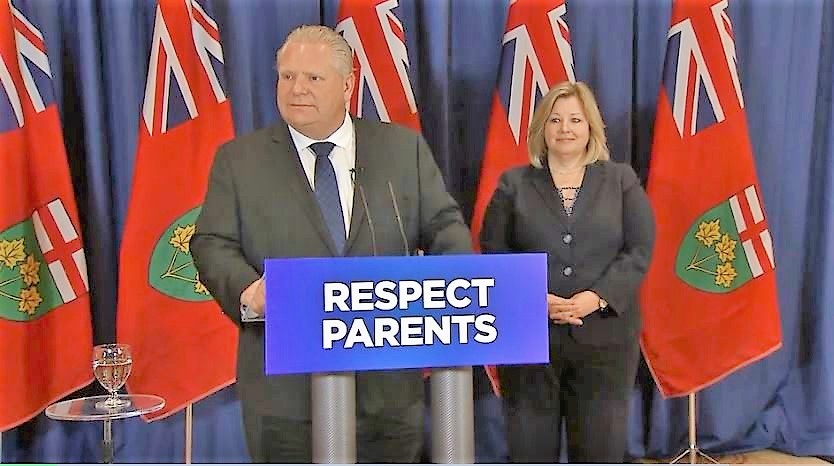
Premier Doug Ford and Education Minister Lisa Thompson.
But peeling away the PC-blue veneer on the numbers reveals that, while the total amount may be increasing, it is not keeping pace with projected enrolment numbers in the province, meaning most schools will receive less money per student for the coming year.
During the current school year, the province spent an average of $12,293 per student, with just over 2 million students in the public education system. This amount will actually drop to about $12,246 for 2019-20, as schools expect to see enrolment province-wide grow by 11,601 students.
For the Peel school boards, that average is even lower, with both the Peel District School Board and the Dufferin-Peel Catholic District School Board being forced to make do with almost $1,000 less per student.
Peel board chair Stan Cameron says that, put simply, the changes mean fewer supports for students. “All schools across the province will have fewer caring adults in the building on any given day,” he says. “That’s a serious concern for us in Peel.”
In part, the reduced funding will be made up for by reducing teacher positions, despite the rising enrolment. In Grade 4-8, the average class size is to rise by one student; in Grades 9-12, the average is rising by six students, to 28 — with many classes much bigger than that to make up for specialized courses with smaller enrolments.
Fewer supports and a reduction in resources for critical programs can have sweeping impacts, Cameron points out.
For example, secondary schools are dealing with a mental health crisis among teenagers, with recent data from the Centre for Addiction and Mental Health (CAMH) showing that nearly 40 percent of students report experiencing a moderate to serious level of psychological distress in the past month. Almost one-third of students report having wanted to talk to someone about a mental health problem in the past year, but did not know where to turn.
To meet these growing concerns, Peel schools are investigating mindfulness programs and training all adults within schools to be access points for students to get help. This means a student in distress at school can turn to any adult in the building, whether it’s a janitor or teacher, and get help or at least be directed where to go for help. But with fewer potential life preservers walking the halls as a result of lower funding, where will students in crisis turn?
“We’re really worried about what that will mean,” Cameron says.
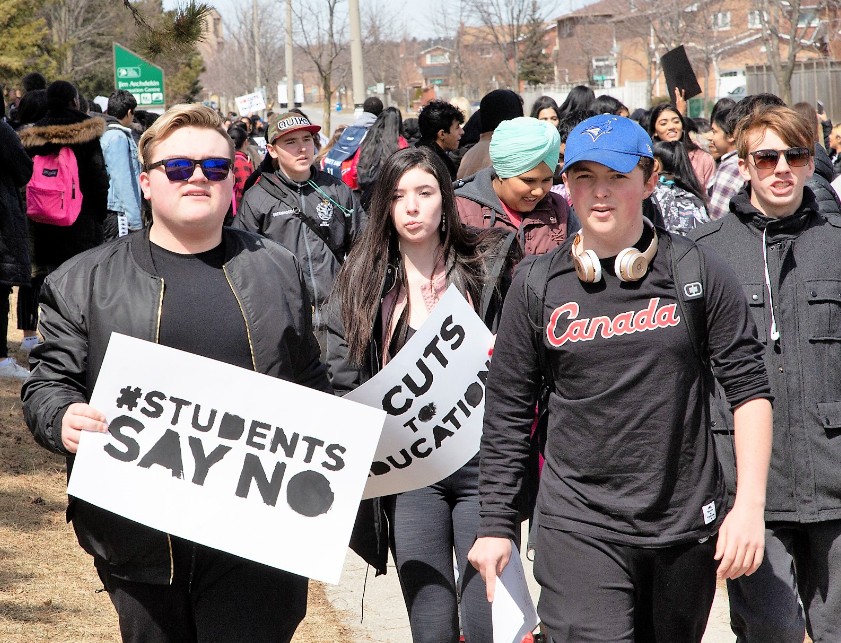
Students have also made their voices heard, holding school walk-outs in protest of the funding cuts.
In recent years, Peel’s school boards have benefited from fairly healthy grant increases from the province. Between the 2015-16 and 2016-17 school years, the Peel District School Board received a $28.2-million increase. The following year, dealing with approximately 2,000 more students, the board was given a $64-million jump in funding. Finally, for this current year’s budget, PDSB received a $43-million bump, bringing the total grant funding to $1.7 billion. Under the projections, next year’s increase is only $4 million, a mere 0.2 percent increase, though the board expects to welcome nearly 900 additional students in the coming year.
Overall, the province has increased education spending by approximately $47.1 million — a far cry from the $685.6-million increase last year and the $969.7-million jump the year before.
Cameron chose not to comment directly on the budget projections, opting to wait until Peel board financial officials have had a chance to analyze the impact. But he says that, generally, the lack of investment across the province will deprive students of resources and opportunities and cost the system many teaching jobs.
The PDSB is preparing to lose 500 secondary school teachers over the next four years. The board has pushed back with a letter to the Ministry of Education, pointing out that, among other things, larger class sizes mean fewer opportunities for students, including specialized vocational and elective courses. And while he acknowledges that the province is on a cost-saving mission, Cameron believes it is going about solving the provincial deficit in the wrong way. “The way they’re doing it is detrimental to the success of our students.”
The Dufferin-Peel Catholic District School Board, which has also enjoyed healthy increases to grant funding over the past two academic years, is now grappling with how to continue to offer needed programming with a projected $8 million cut in funding, while dealing with an increase in students. The board’s enrolment had been in decline for the past couple of years but is now expected to rise for the first time since the 2015-16 school year. Current projections will force the Catholic board to operate with per-pupil funding below the provincial average, at $11,424 for the coming school year.
As Brampton is the second fastest growing city in the country and PDSB the second-largest school board in Canada, this lack of funding for Peel has become a commonly heard refrain at Queen’s Park.
On Wednesday, Brampton MPP Sara Singh (Brampton Centre-NDP), criticized the direction the PCs are taking on education.
“Thousands of fewer teachers, bigger class sizes and less help for kids — this is not the way forward for our province and, in fact, these callous cuts to our education system are actually dragging our province in the wrong direction,” she said. “That couldn’t be more evident than in the Region of Peel, where more than 360 teachers with the Peel District School Board have learned they will no longer have permanent positions heading into the new school year. That is shameful.”
Similar reductions are being noted across Ontario, but for many boards, while the funding may be reduced overall, the per-pupil amount remains closer to the provincial average. In Toronto, both the TDSB and the Toronto Catholic board are taking cuts of $21 million and $4.5 million respectively. Yet, the Toronto Catholic board will maintain a per-student average of just over $12,000 and the TDSB will hover just below the Ontario average at $12,238.
Comparisons under these terms are difficult. When looking at all 76 of the province’s school boards, they vary greatly in size and need. For example, the more northern school boards, while having much smaller student enrolment, require much higher transportation grants, as more students need to be bused to school than in urban centres like Toronto or Mississauga. These discrepancies and different economies of scale often result in smaller boards having substantially higher per-pupil funding averages — sometimes nearly three times more than their urban counterparts.
One such example is the Conseil Scolaire de District Catholique des Aurores Boreales in Thunder Bay. With $24.3 million in grant funding and projected enrolment of only 840 students, the board’s per-pupil funding average is approximately $28,974. The Northwest Catholic District School Board in Kenora, with 1,200 students, has a $23.3 million budget, equating to $19,466 per student. Finally, the Northeastern Catholic District School Board in Timmins, with almost 2,200 students and a $39.3-million budget, will receive $17,888 per student.
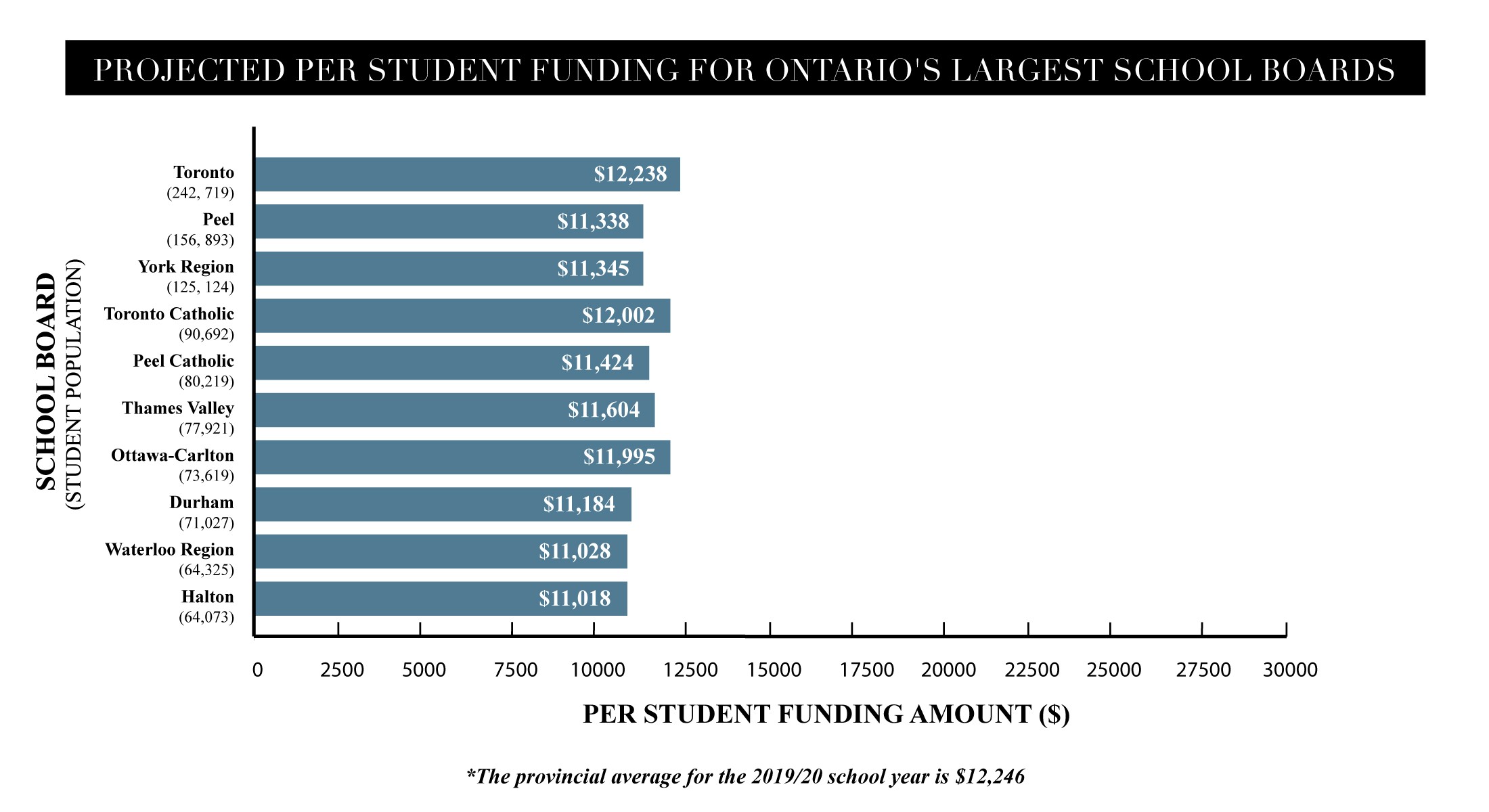
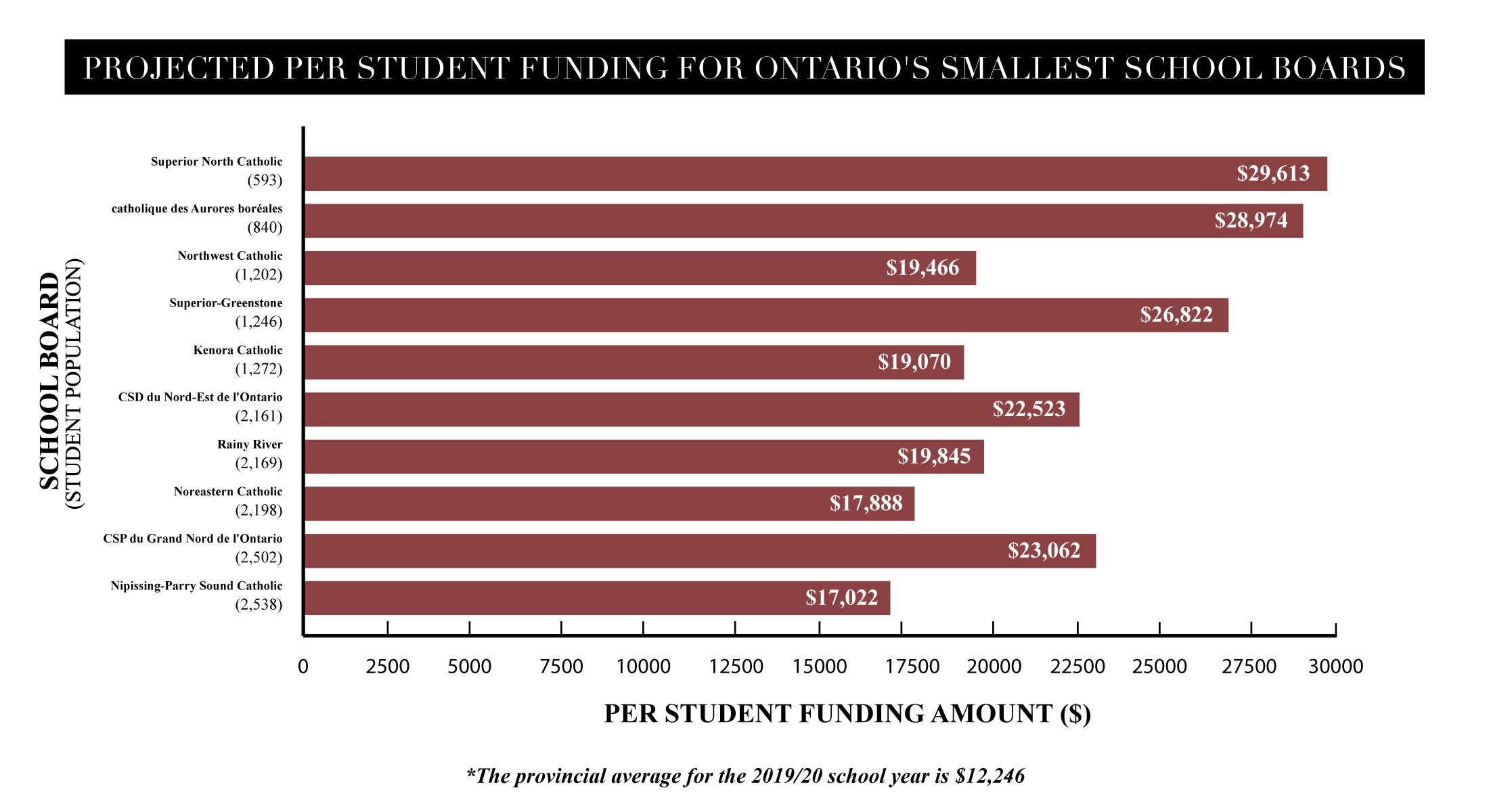
There are longstanding concerns that the province’s funding formula has serious problems.
Ever since the province took over full responsibility for education funding in 1997 with the Education Quality Improvement Act, stakeholders have been pointing out flaws in the way funding is distributed to Ontario school boards and how this has led to major reductions in education spending.
According to a 2017 report from the Elementary Teachers Federation of Ontario (ETFO), the formula was designed to reduce operating spending previously tied to enrolment and adjusted for inflation. In 1997, this new funding model resulted in spending being reduced by $833 million. By 2002-03, that reduction amounted to $1.7 billion below the pre-formula amount.
The former PC government under Mike Harris created a panel to review the formula in 2001-02. The independent report recommended a $1.7-billion infusion of cash into the system and pointed out that the formula had led to a $5.6-billion maintenance backlog; schools were deteriorating because boards chose to devote their inadequate funding to classroom needs.
That report, completed by Mordechai Rozanski, former president of the University of Guelph, also pointed out that the formula was leading to poor investment in other priority areas.
“Rozanski went beyond his mandate to highlight the negative consequences of the formula’s fixation with uniformity and its inadequate funding for special education, programming for students at risk and support for students whose first language is neither English nor French,” the ETFO report says.
When the Liberals were elected in 2003, they set about fixing some of these front-of-mind issues, reducing class sizes and addressing poor funding for special-ed. However, according to the ETFO, they also ignored many of the foundational problems with the funding formula, so the issues persist to this day.
Global News reported in February that, according to its sources, the provincial government is looking to merge some of the smaller school boards to gain efficiencies, but the PCs have made no such announcement.
When presented with the numbers for Peel and its below-average per-student funding, Cameron admitted he was unaware of those numbers, and was flabbergasted.
“I would have no idea how that could be justifiable,” he said. “We are a growth board, we continue to increase in enrolment … how we can be funded even a penny less than the average across the province is astounding to me. We need every penny we can get.”
This isn’t the only instance of Peel Region seemingly not getting its fair share of provincial money. Brampton, for example, has had one of the lowest funded healthcare systems on a per capita basis since as far back as 2009, culminating in the crisis that led to the popularization of the term “hallway healthcare” at the city’s lone full-service hospital, Brampton Civic.
Peel Region’s public health unit is one of the lowest funded, per capita, in the province, and the region’s only registered Sexual Assault Centre is the second lowest funded in Ontario.
The Peel District School Board has raised the alarm about underfunding in the past. A 2013 campaign titled Fix the Formula argued for increased investment in special education in Peel, which at the time was being underfunded for such programs to the tune of $14 million to $16 million a year.
And it’s a self-perpetuating problem.
For the 2019-20 school year, Cameron says the PDSB is set to receive a 4 percent bump in funding for transportation needs. However, this increase does nothing to address the more than 15 percent increase the board was forced to swallow this year in order to hire and keep enough drivers to meet demands.
The Peel community is not keeping quiet on this front. Members of the Peel District of the Ontario Secondary School Teachers Federation, the union representing approximately 3,500 teachers and other education professionals within the board, are set to protest Friday outside the office of MPP Amarjot Sandhu (Brampton West–PC).
“The Ford government’s budget cuts to public education will have a devastating impact on every student in Ontario’s public education system. Over 60 percent of voters in Brampton West did not vote for MPP Sandhu or the Ontario government’s funding cuts to public education,” says a press release from the union. “OSSTF District 19 Peel wants MPP Sandhu to understand that these cuts are simply not acceptable, and that the government must enhance funding to support the economic growth of our province.”
Sandhu and fellow MPP Prabmeet Sarkaria (Brampton South–PC) had not responded to a request for comment as of publication.
Email: [email protected]
Twitter: @JoeljWittnebel
Submit a correction about this story


